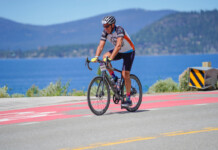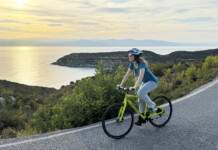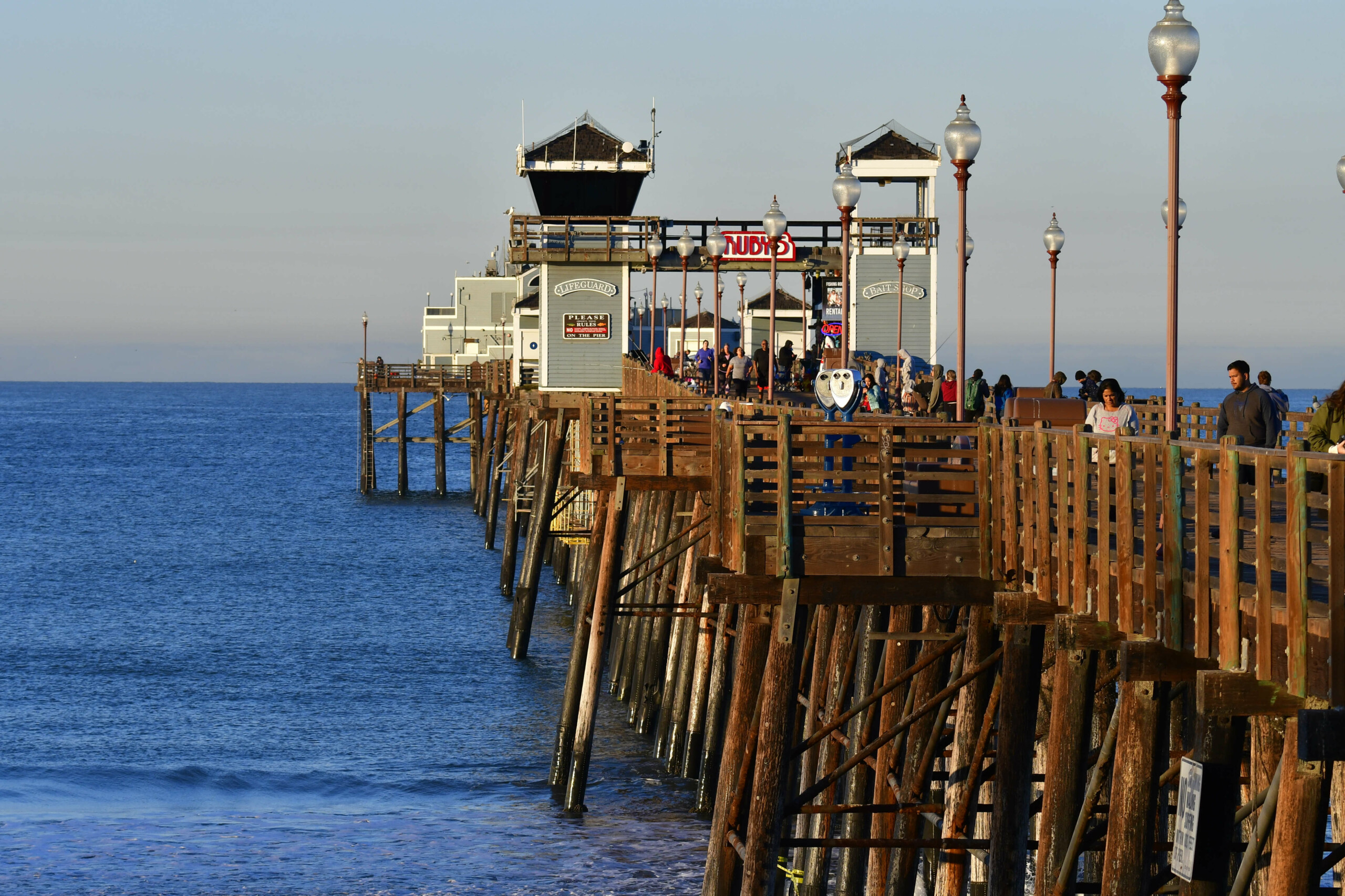Just Before the Main Roads Open to Cars for the Year, Yellowstone Allows Cyclists to Tour a Section of the Park’s Roads
By Clark Corbin — WEST YELLOWSTONE — Three of us were walking our bicycles through the barricaded entrance to the world’s first national park when the driver of a black minivan slowly approached the “road closed” sign, turned to their passenger, shrugged and started to turn around.

We smiled, pulled our gloves on, kicked a leg over the frame of our bicycles and started pedaling east.
Yellowstone National Park stretched out before us, the mountains and sprawling valleys covered in a blanket of deep, white snow.
“It feels like we unlocked a cheat code,” said journalist Heath Druzin, who along with his wife, Miriam, and 15-month-old daughter joined me for the ride.
“How often do you get to be in Yellowstone completely alone?” Heath asked later.
Each spring Yellowstone National Park and Grand Teton National Park officials open sections of the parks’ main roads to bicyclists just before they open those roads to vehicles for the year.
Until the main roads open, there is limited public access to Yellowstone National Park, services are limited and most roads are closed to public vehicle travel. That said, park employees are allowed to drive vehicles, snow plows and equipment through the park’s roads to prepare for opening the main roads to the public, and we did see several of them during our ride.
This year, Yellowstone National Park officials opened a 49-mile section of main roads from the West Entrance, north to the Norris Geyser Basin and continuing to Mammoth Hot Springs to bicyclists on April 7. A few days later, park officials announced they will open those roads and other main park roads to public vehicles beginning at 8 a.m. Friday.
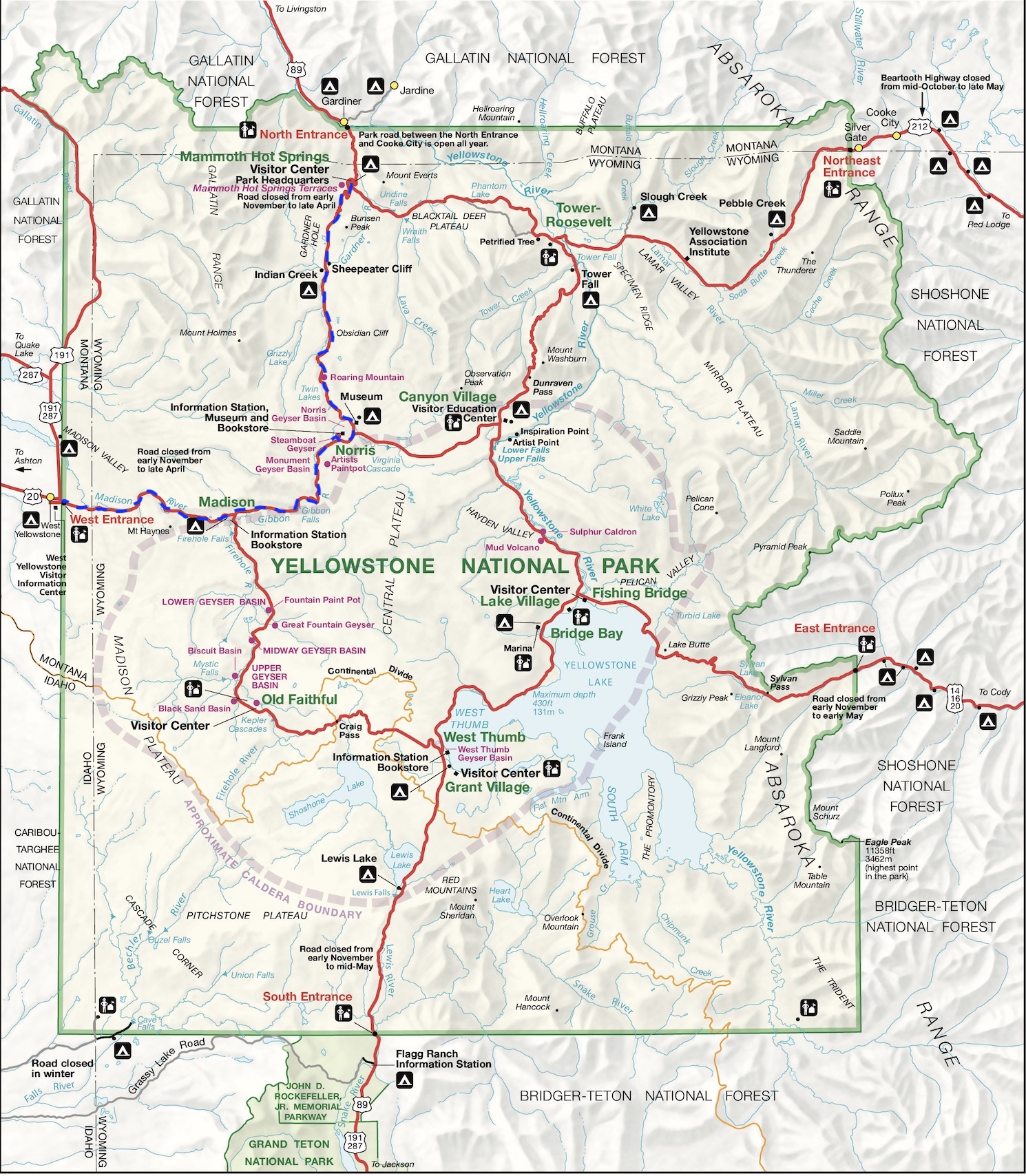
There is also a fall bicycling season in Yellowstone after the main roads close to public motorized vehicles in November. Bicyclists are also allowed on the roads at the same time as cars during the summer as well. Aside from the main roads, there are a handful of dedicated bike trails in the park, including an abandoned railroad bed and paved trails.
What is different about riding a bicycle in Yellowstone without cars?
Last year, Yellowstone hosted 3.3 million recreation visits, with more than half of those visits concentrated in June, July and August, according to a news release from Yellowstone National Park.
Anyone who has driven through Yellowstone during the summer months has experienced traffic jams known as “bison jams” and “bear jams” that can lead to traffic backing up for a quarter of a mile or more while tourists step outside their vehicles, craning their necks to catch a glimpse of wildlife.
Bicycling through the park in April is pretty much the opposite of that.
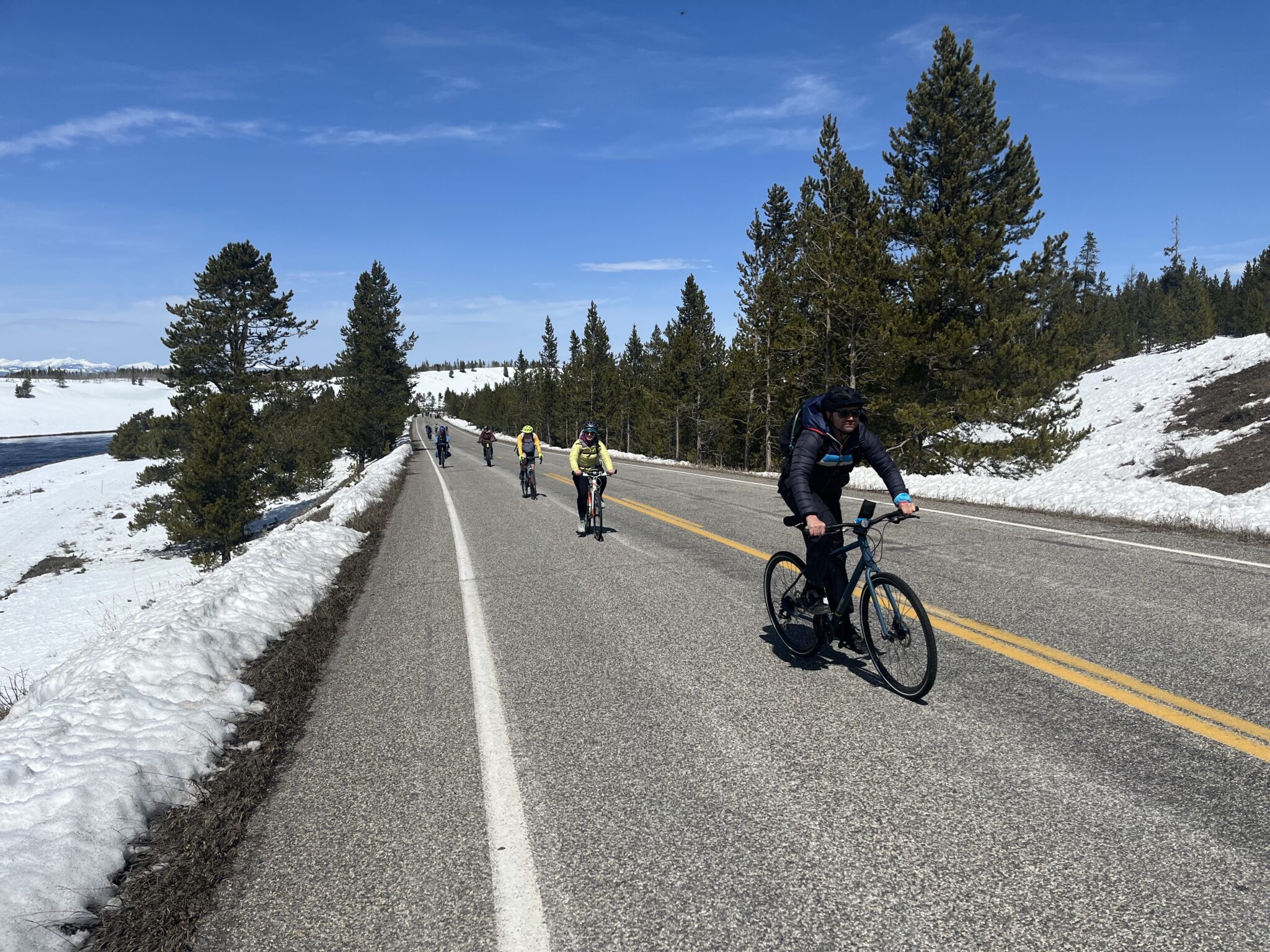
With the sun shining overhead and a cold wind nipping at our cheeks, we followed the Madison River and watched the park slowly awaken from a long winter.
Water dripped from snow drifts piled up beside the road and the banks of the river.
Wind whistled through Douglas-fir forests.
Tree branches creaked and groaned under the weight of melting snow.
Every so often, natural avalanche debris fields littered mountainside slopes. Well before we arrived in the park, a few avalanches deposited tangled mounds of boulders and snapped tree trunks in heaps of rubble that nearly reached the park’s roads.
We eased our bicycles to a stop, pulled binoculars from our packs and watched as a coyote trotted along the far bank of the Madison River.
We snapped a few grainy photos from a distance of 200 yards and hoped that spotting the coyote within 20 minutes of entering the park was a good omen for more wildlife encounters.
The 14-mile section of road between the West Entrance and Madison Junction is mercifully flat, with a handful of short, rolling climbs and descents.
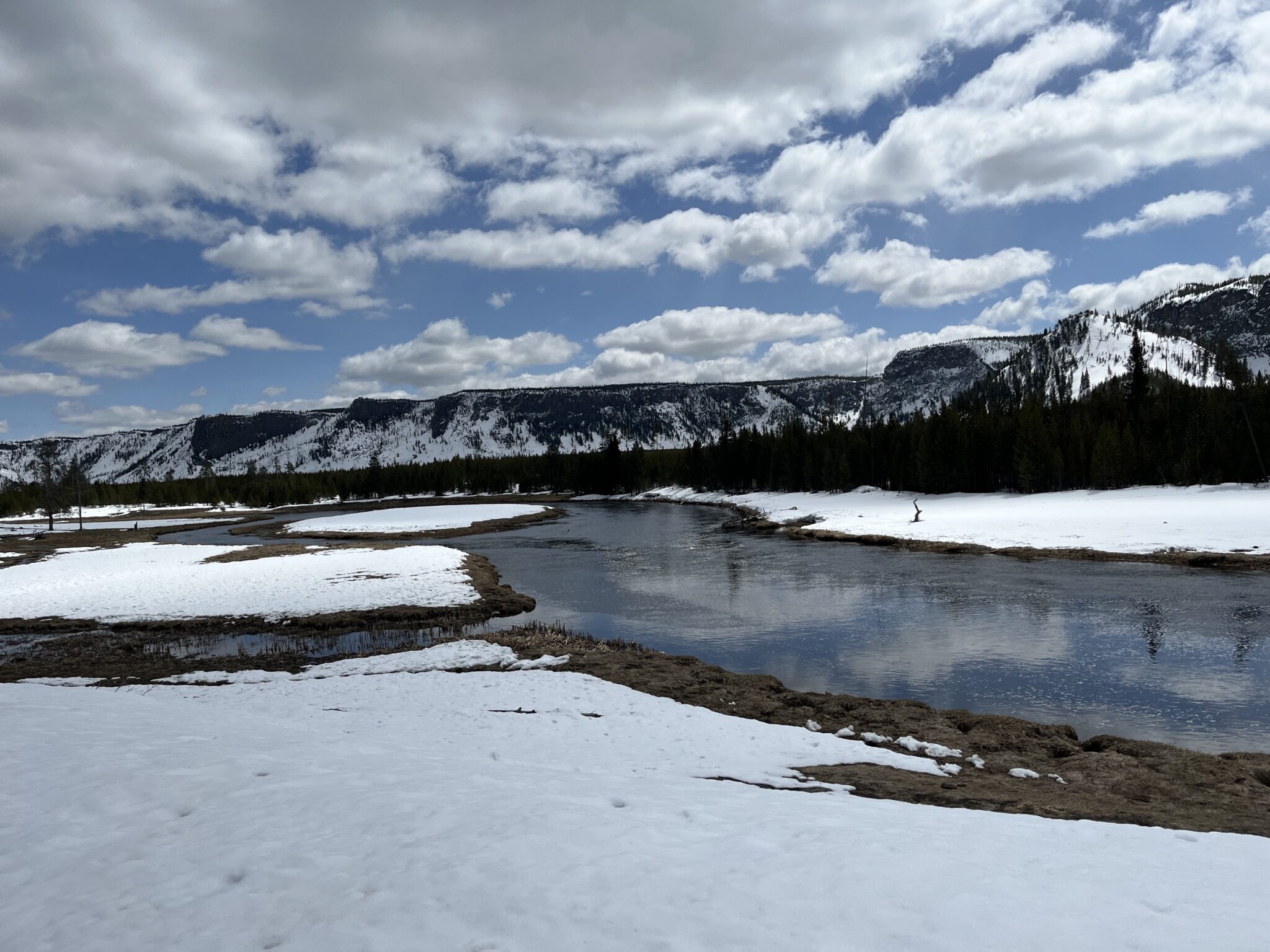
For two sunny days last weekend, we fell into a pattern, alternating between riding and stopping for rests, checking on Heath and Miriam’s daughter and watching for wildlife. We dressed in layers like we were skiing and we kept a mellow enough pace to maintain a conversation as we pedaled. I carried bear spray and rode a mountain bike. Miriam and Heath rode road bikes, with Heath pulling his bundled up daughter in a toddler trailer. (Remarkably, she slept most of the way and cooed softly to her stuffed animals and blankets at other points.)
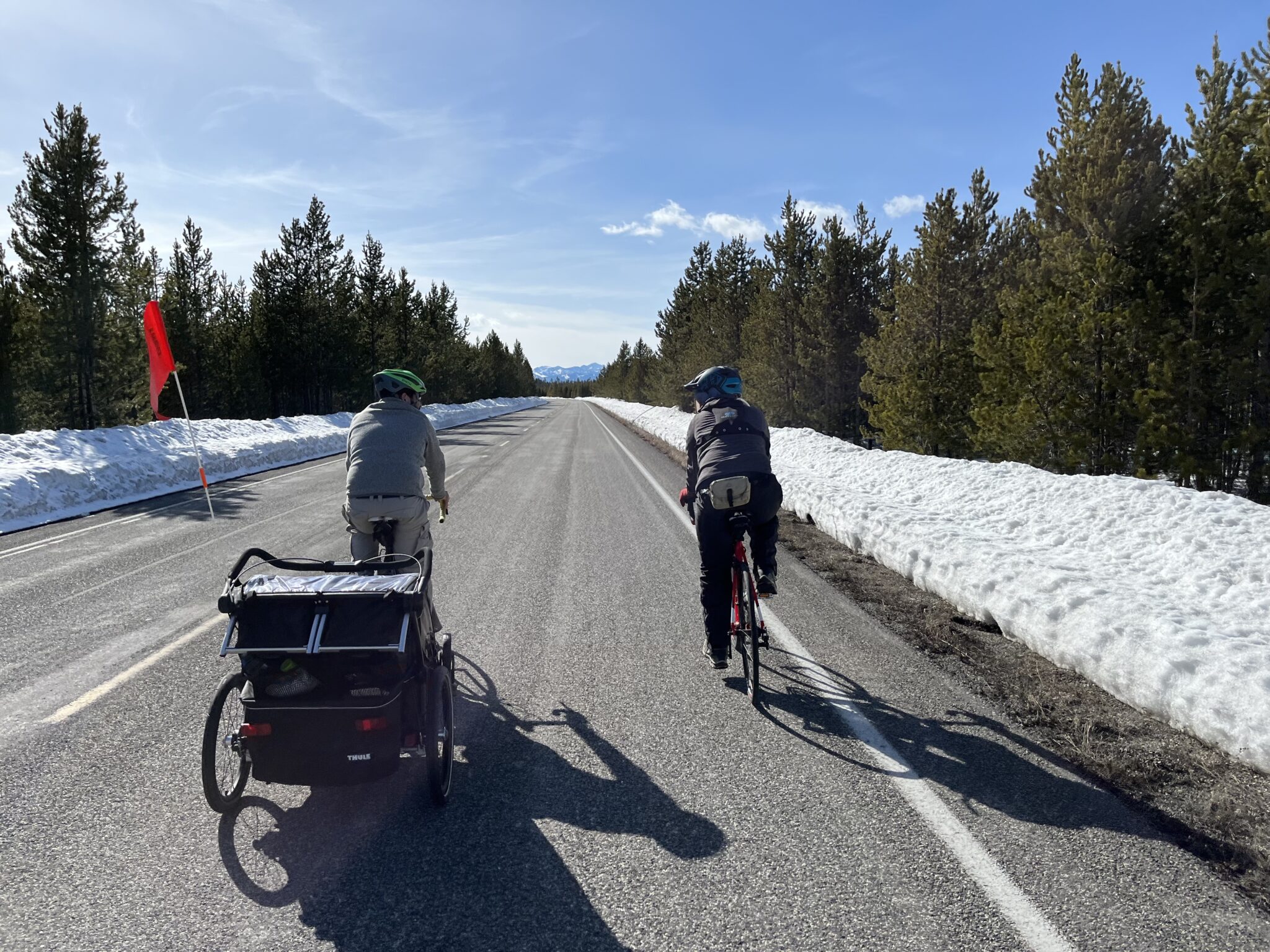
Watching for wildlife, seeing the national park in a new way
Rather than zooming through the park at 45 mph in a car during the tourist season, our pace allowed us to take in the park at a slower speed.
We focused on watching for wildlife we might have otherwise missed.
A fox leapt high into the air and pounced downward into the snowpack, hunting for its next meal.
A bison waded slowly across the Madison River.
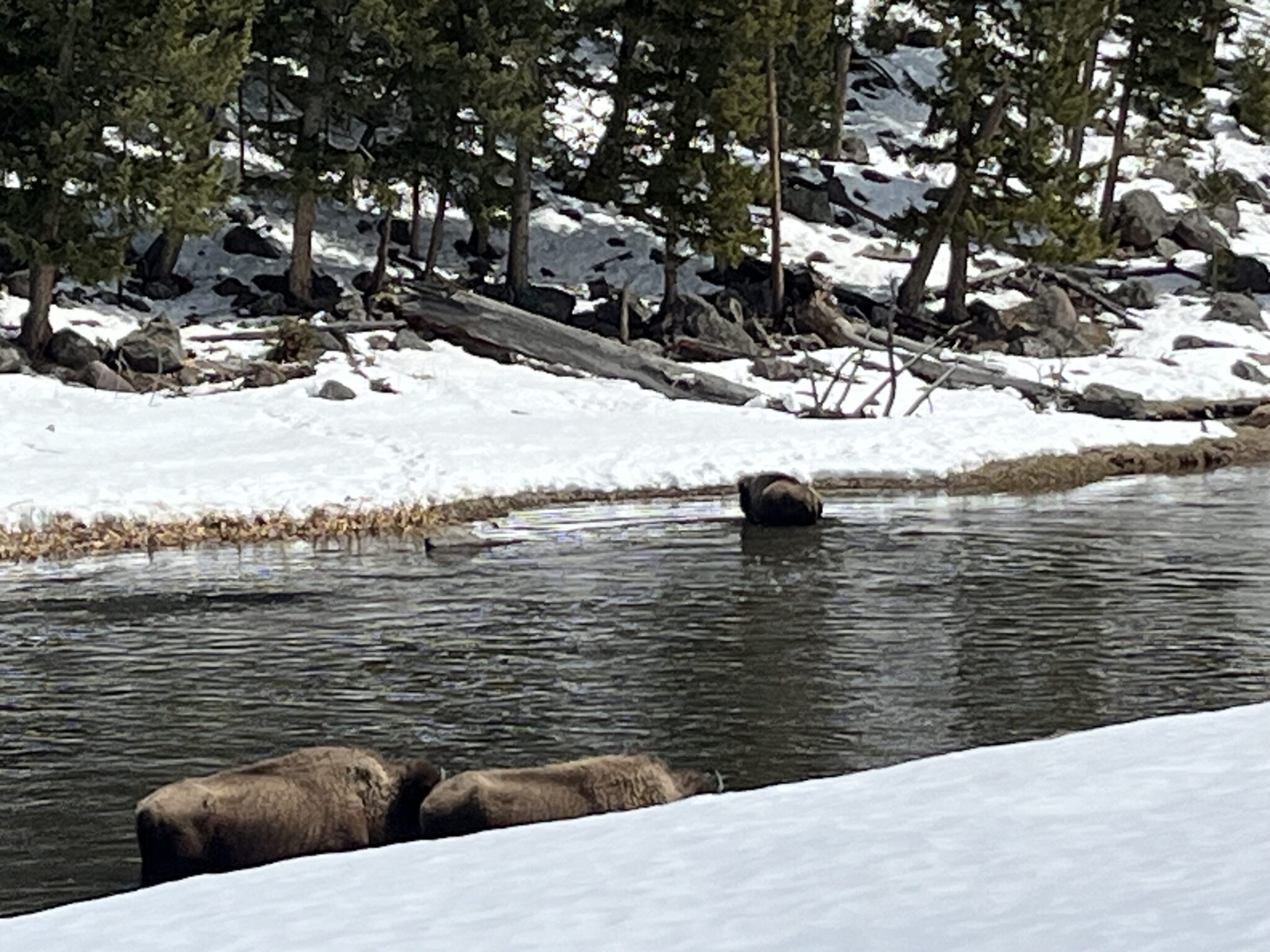
A bald eagle soared along the river’s edge, its long, broad wings stretched out flat in flight.
Beavers, an otter, loons and geese all came out on the river.
After reaching Madison Junction, we turned north and pedaled uphill.
A short distance later we stopped in the small parking area for a geothermal feature called Penny Pond and ate a picnic lunch. We stretched out on the pavement in the sun as steam rose off the nearby hot pool.
After a long lunch, the wind picked up and we headed back toward the West Entrance, retracing the same roads as before.
The trip covered just over 32 miles, out and back, reaching an elevation of about 6,900 feet.
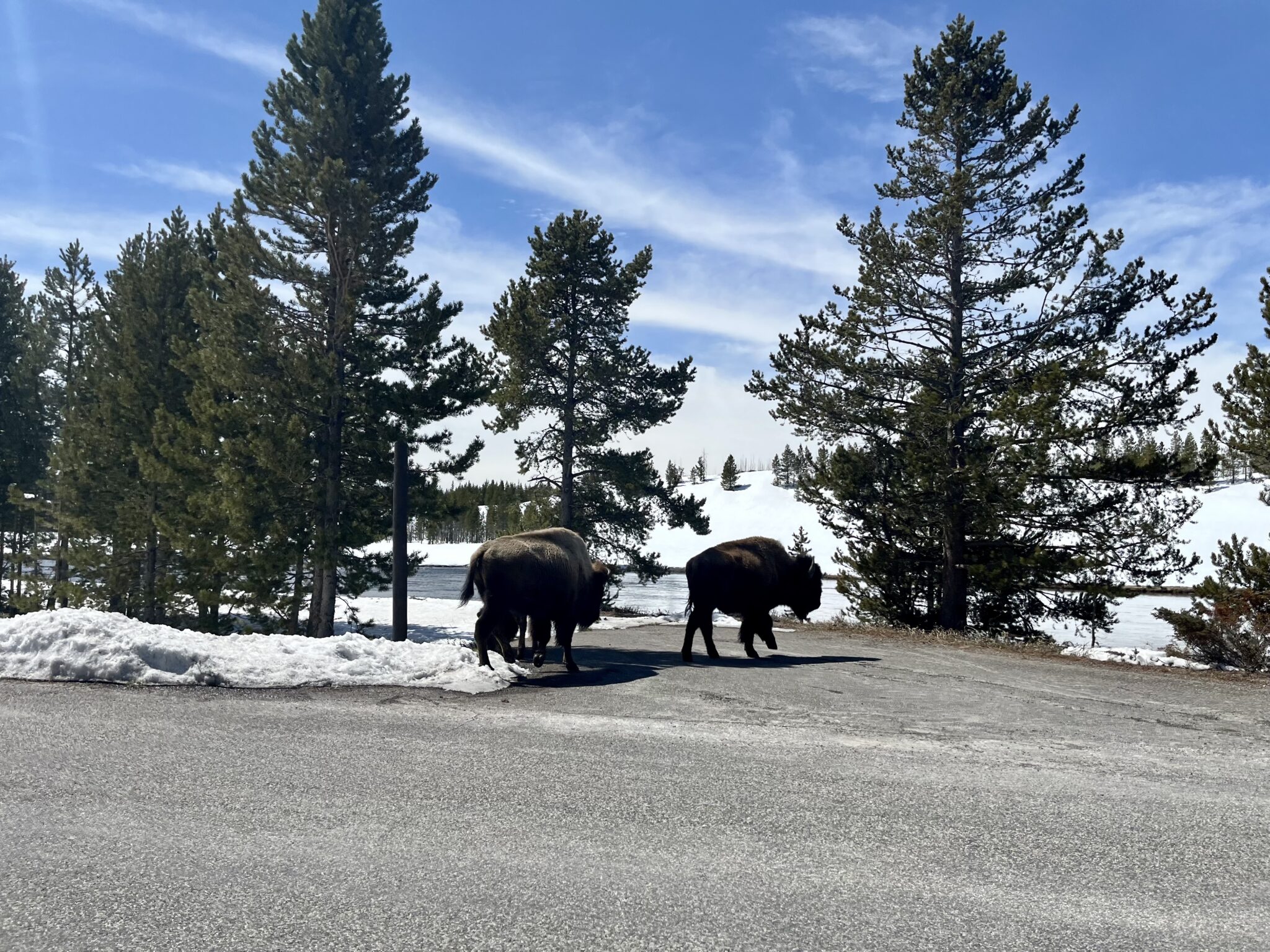
It was so incredible that we returned the next day and covered 22 miles, turning around a little before Madison Junction.
We saw about 50 other cyclists on Saturday and more than 100 on Sunday. Adults of all ages, children and several toddlers riding in trailers all crossed our paths on the ride.
One of the last people I saw before leaving the park was a man wearing a cowboy hat and a smile that stretched ear-to-ear. A small black and white dog was riding with him inside of a milk crate attached to his bicycle.
Tips for riding a bicycle in Yellowstone during the unpredictable spring weather months
We lucked out with nice weather during our rides — sunny skies and temperatures in the mid 40s on Saturday and low 50s on Sunday.
But when Yellowstone National Park officials announced they were opening some of the main roads to bicyclists, they warned people to be prepared for bad weather, snow, ice and remote conditions.
“No services will be available, except limited restrooms,” park officials wrote in an April 5 press release. “Plan for self-rescue or repair. Cell phone coverage throughout the park is sparse and unreliable for communicating emergencies. Prepare to spend an extended period in winter conditions in the event of a mechanical breakdown, injury or other emergency.”
Rapid temperature changes and sudden snow storms are possible on any day of the year in Yellowstone National Park.
Yellowstone officials asked bicyclists to carry bear spray and be prepared to keep plenty of distance from large animals that could be stressed out from a long winter using the roads to avoid traveling in deep snow. Yellowstone officials warn visitors to stay 100 yards away from bears and wolves and 25 yards away from all other wildlife.
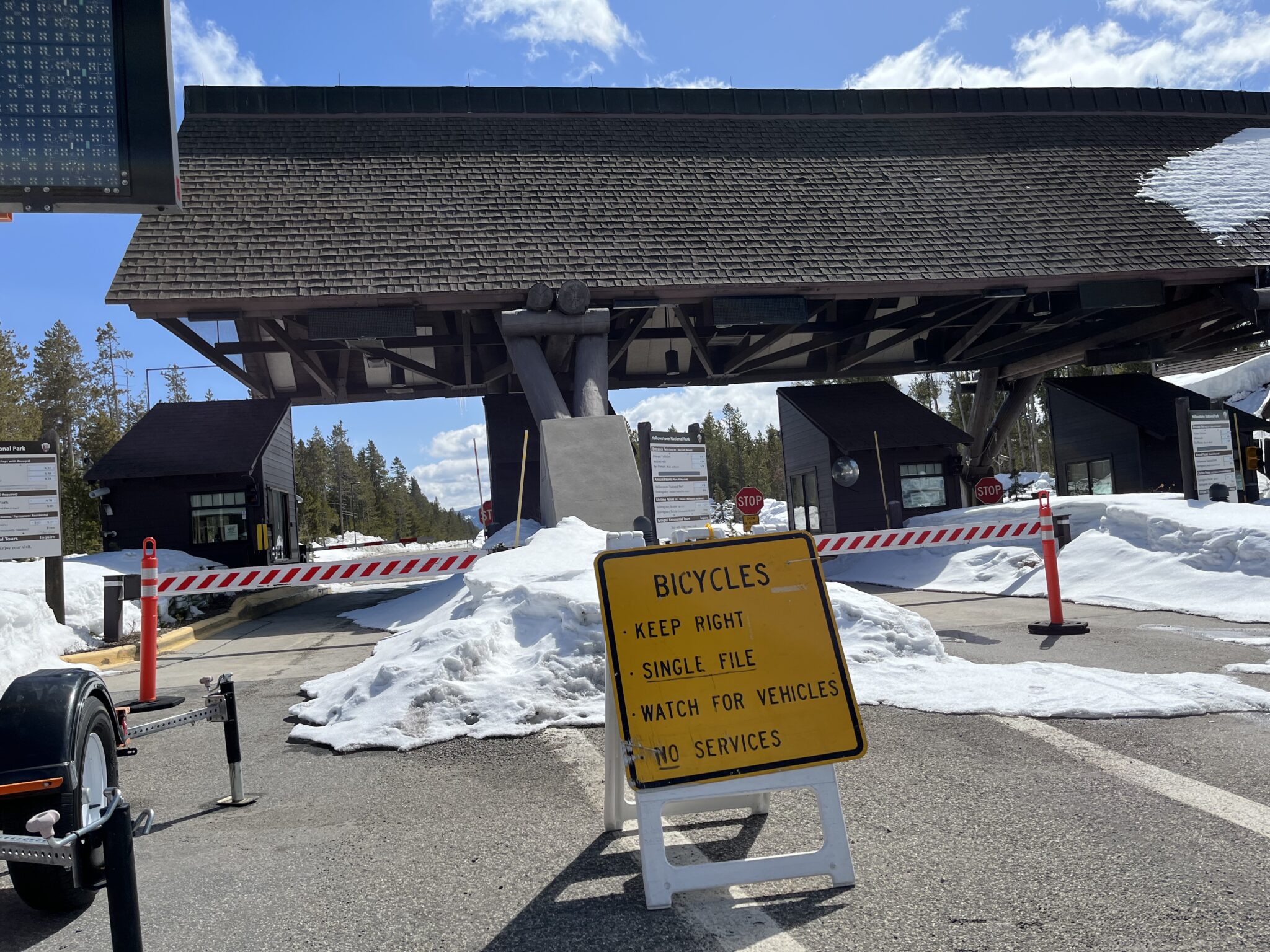
There was no entrance fee at Yellowstone’s West Entrance, and we didn’t need a permit or reservation or to check in with park officials. Many cyclists parked their cars in downtown West Yellowstone, Montana, or just outside of the park’s entrance and rode their bicycles in from there. Bicycles are also available to rent at Freeheel and Wheel in West Yellowstone, but advance reservations are recommended.
Bicycling is only allowed during daylight hours, and bicycling is prohibited on backcountry trails, boardwalks and oversnow routes.
Additional tips and bicycling guidelines are available on Yellowstone’s website.
Some experienced Yellowstone cyclists plan to stay in West Yellowstone, Montana, just outside the park’s West Entrance, for a few days in an attempt to avoid bad weather.
“I would say have two days just in case. If you drove all the way from Boise and it was storming one day, it would be a bummer,” said Susan Damm from Boise, who has ridden her bicycle in Yellowstone with friends for 11 years. “Plan for two days and hope that one is nice.”
Damm rode with a group of 17 friends this year. She said she rode under beautiful clear skies and thinks the snowpack is as epic and deep as she has ever seen it this year.
“We enjoyed being together because we had some new riders in our group, which is always fun because they are enjoying it for the first time,” Damm said.
Damm recommends riding in a group with friends for safety. Over the years she has been glad to have others there to lend a helping hand, particularly one year when she crashed her bicycle and damaged it five miles into a ride.
But with preparation, a supportive group and halfway decent weather, Damm said the rewards are worth the effort.
One year, her group ran into a herd of at least 50 bison and had to wait for the animals to cross the road so the cyclists could ride passed, single-file.
Damm looks forward to the spring bike rides because it’s such a different way to see the park and avoid crowds.
“We’ve been there all four seasons, and it’s just that you’re not fighting the crowds,” Damm said. “There is hardly anybody there and you can ride a bike on the road because it is actually safe at that time. There is just that safety to be able to ride and experience the park from two wheels versus four wheels.”
Idaho Falls man forges lifelong friendships over mellower cycling trip through Grand Teton National Park
The undisputed king of riding a bicycle through national parks before the cars arrive is a man named Matt Stanger who lives in Idaho Falls.
Stanger started riding through Yellowstone in the mid-1990s while he was working at the former Alpine Schwinn bicycle shop.
Young and fit, Stanger and his buddies were always riding bicycles when they weren’t working on them.
For four years, Stanger took long April bike rides into Yellowstone — 30-some miles in, plus 30-some miles out.
Seeing Yellowstone without cars blew him away, but he knew his ‘friend-friends’ who weren’t avid cyclists would never go for such a long ride.
The next year, Stanger mixed it up. He and his wife, Amy, rode bicycles into Grand Teton National Park right before it opened to cars and picked a mellow, four-mile stretch of the Teton Park Road between the Taggart Lake Trailhead and the Jenny Lake boat dock.
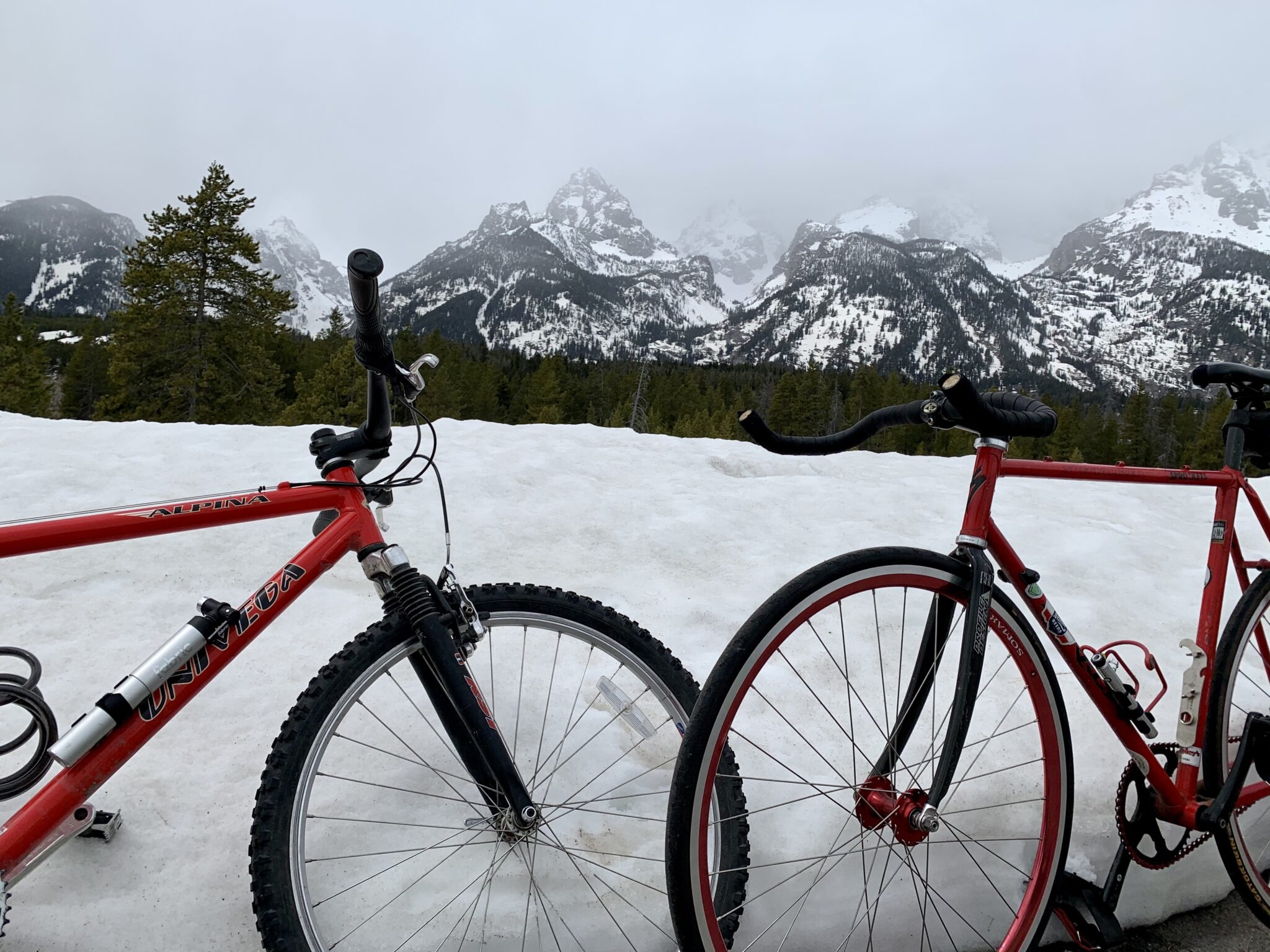
“Amy and I went into Grand Teton National Park and it was incredibly cool, and from there I knew I could get people who weren’t, you know, bike fanatics to come enjoy something so wonderful,” Stanger said.
The next year, he invited five friends.
The next year after that, attendance doubled.
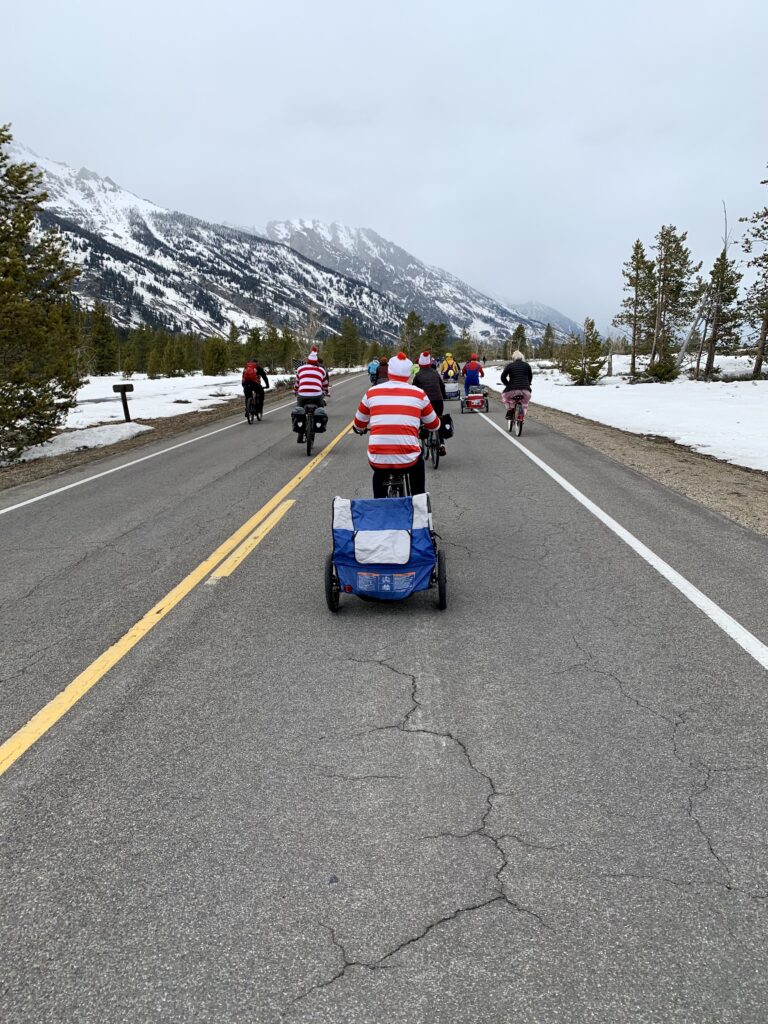
The ride turned into a celebration, with people drinking beer and sometimes donning “Where’s Waldo?” costumes or neon tutus.
It became a loose, unorganized tradition of friends who took to calling it the No Motor so they could have a name for the Facebook page they started to share photos from their rides.
Later this month, Stanger is preparing to ride into Grand Teton National Park for the 23rd year with friends.
“We’ve had cold and wind and snow that’s blowing as hard as you can ever imagine,” Stanger said. “Fog you can’t see through. One year there was lighting.”
Despite the elements, Stanger said the vibe has always been celebratory. He estimates he has made more than 100 friends and facilitated dozens of other friendships among strangers during almost 25 years of riding bicycles into Grand Teton National Park.
“The way I like to frame it is really around gratitude,” Stanger said. “It’s gratitude for spring, it’s gratitude for the national park system, it’s gratitude especially for Grand Teton National Park and those gorgeous mountains we have right outside of our doorstep.”
“What the real appeal is and the reason it works so well is that that amount of gratitude for all of those things makes people wonderful,” Stanger said.
Details:
April 1-30 — Yellowstone Cycle Days, TENTATIVE AND APPROXIMATE DATES – Check the Yellowstone Park Website in March, Yellowstone National Park, MT, Ride free in Yellowstone National Park before the roads open to the public. This is a unique way to enjoy the beauty of the park. Opening day depends on whether the road is plowed. Check for park service website to see if the roads are open., nps.gov/yell/planyourvisit/bicycling.htm
Note: ‘Hardly anybody there’: How to bicycle through Yellowstone National Park without cars by Clark Corbin, originally published in the Idaho Capital Sun, April 21, 2023




